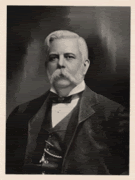Thank God for this brilliant man.
Interesting little historical trivia here:
Westinghouse's promotion of AC power distribution led him into a bitter confrontation with Edison and his DC power system. The feud became known as "the War of Currents." Edison claimed that high voltage systems were inherently dangerous; Westinghouse replied that the risks could be managed and were outweighed by the benefits. Edison tried to have legislation enacted in several states to limit power transmission voltages to 800 volts, but failed.
The battle went to an absurd, and some would say tragic, level, when in 1887 a board appointed by the state of New York consulted Edison on the best way to execute condemned prisoners. At first, Edison wanted nothing to do with the matter, declaring his opposition to capital punishment.
However, Westinghouse AC networks were clearly winning the battle of the currents, and the ultra-competitive Edison saw a last opportunity to defeat his rival. Edison hired an outside engineer named Harold P. Brown, who could pretend to be impartial, to perform public demonstrations in which animals were electrocuted by AC power. Edison then told the state board that AC was so deadly that it would kill instantly, making it the ideal method of execution. His prestige was so great that his recommendation was adopted.
Harold Brown then sold gear for performing electric executions to the state for $8,000. In August 1890, a convict named William Kemmler became the first person to be executed by electrocution. Westinghouse hired the best lawyer of the day to defend Kemmler and condemned electrocution as a form of "cruel and unusual punishment". The execution was messy and protracted, and Westinghouse protested that they could have done better with an axe. The electric chair became a common form of execution for decades, even though it had proven from the first to be an unsatisfactory way to do the job. However, Edison failed in his attempts to have the procedure named "Westinghousing".


No comments:
Post a Comment